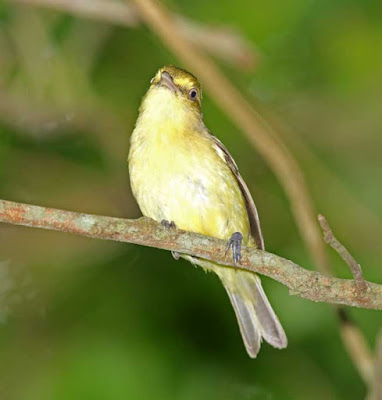On the Pacific side of Guatemala adjacent to Chiapas Mexico are some wonderful wetlands. These were originally used for shrimp farming, but many ponds are now overgrown with marsh reeds and mangroves and provide excellent habitat for a number of species. The Mangrove Vireo in the previous bulletin was found here.
Bitterns are the most secretive members of the heron family. There are 14 species in the world, but only 4 in the Americas. Two are in USA (American and Least) and I saw a third one in these ponds. The 28" Pinnated Bittern (Botaurus pinnatus) is very similar to our American Bittern but 6 inches taller. Also, the black barring on the back of the neck is a good field mark to differentiate them. We saw 7 birds in the ponds, but without the sharp eyes of the guides, I would not have seen them as they stay pretty motionless in the reeds.
 |
| Pinnated Bittern |
 |
| Bare-throated Tiger-Heron - adult |
Also we found a juvenile. He has a striped back.
 |
| Bare-throated Tiger-Heron - juvenile |
The 9" Northern Jacana (Jacana spinosa) were fairly common here and I got my best photo ever of this bird.
 |
| Northern Jacana |
Also a 16" Rufous-naped Wood-Rail (Aramides albiventris) was seen. If this name is unfamiliar to you, it was formerly the Gray-necked Wood-Rail. The species was split a few years ago and the northern birds given this name by the IOU. The AOU has a different name for this bird, Russet-naped Wood-Rail.
 |
| Rufous-naped Wood-Rail |
Before we drove to the wetlands, we got up before dawn to see the 9.5" Pacific Screech-Owl (Megascops cooperi). This was a lifer.
 |
| Pacific Screech-Owl |
The 6.5" Guatemalan Pygmy-Owl (Glaucidium cobanese) is resident in the mountains of from southern Mexico to Costa Rica. As a diurnal owl, it is fairly easy to see by playing the tape and if one is in the vicinity, it will promptly fly in. This owl was also a lifer.
 |
| Guatemalan Pygmy-Owl |
 |
| Ferruginous Pygmy-Owl |
Pygmy-Owls catch and eat small birds. They have an interesting adaptation, as on the back of their head are feathers that resemble another pair of eyes. I would presume this is to confuse their prey as to whether they are being watched or not. Here is the back of the head of this bird.
 |
| Ferruginous Pygmy-Owl |
Needless to say, these owls are unwelcome in the neighborhood and other small birds will mob and attack to owl to try and drive it away. This is why guides will play the tape of a local pygmy-owl to bring in smaller birds. Here is the owl being attacked by a much smaller 4" gnatcatcher.
 |
| Ferruginous Pygmy-Owl mobbed by a gnatcatcher |
I have put the different bird families in single folders for easy perusal.
I have photos of 25 of the 66 herons
And I have photos of 12 of the 138 rails and coots.
And I have photos of 3 of the 8 jacanas.
And I have photos of 24 of the 216 typical owls
Happy birding and photography,
David McDonald
dkmmdpa@gmail.com
photos copyright 2006 - 2017 David McDonald
To have these trip reports sent to your email, please email me at the above address and ask to subscribe.










